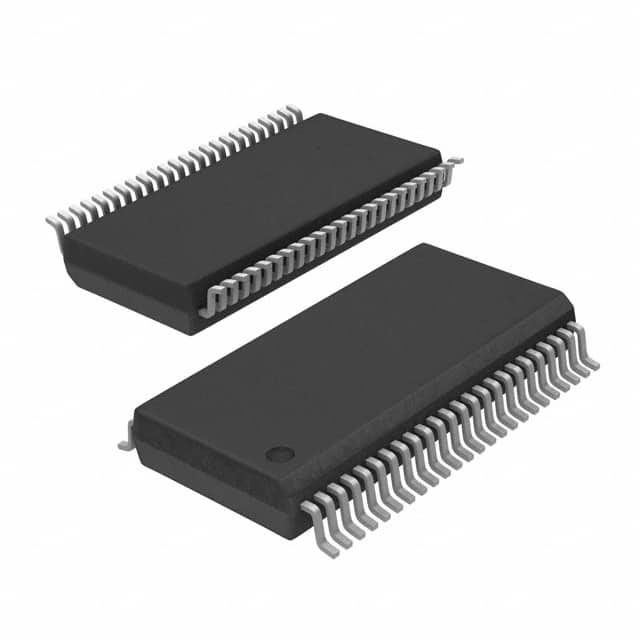Lihat spesifikasi untuk detail produk.

CY74FCT16245ATPVC
Basic Information Overview
- Category: Integrated Circuit (IC)
- Use: Buffer/Driver
- Characteristics: High-speed, low-power, 16-bit bidirectional transceiver
- Package: TSSOP (Thin Shrink Small Outline Package)
- Essence: Transfers data between two bidirectional buses
- Packaging/Quantity: Tape and Reel, 2500 units per reel
Specifications
- Number of Bits: 16
- Logic Family: FCT (Fast CMOS TTL)
- Supply Voltage: 4.5V to 5.5V
- Input/Output Type: Tri-State
- Operating Temperature Range: -40°C to +85°C
- Propagation Delay: 3.8ns (typical)
- Output Drive Capability: ±24mA
Detailed Pin Configuration
The CY74FCT16245ATPVC has a total of 48 pins, which are divided into four groups: - Group A: Pins 1 to 12 (A1 to A12) - Inputs/Outputs for Bus A - Group B: Pins 13 to 24 (B1 to B12) - Inputs/Outputs for Bus B - Group C: Pins 25 to 36 (DIR, OE, GND, VCC, NC, NC, NC, NC, NC, NC, NC, NC) - Control and Power Pins - Group D: Pins 37 to 48 (B12 to B1) - Inputs/Outputs for Bus B (in reverse order)
Functional Features
- Bidirectional Data Transfer: Allows data to be transferred in both directions between Bus A and Bus B.
- Tri-State Outputs: The outputs can be put into a high-impedance state, allowing multiple devices to share the same bus without interference.
- Direction Control (DIR): Determines the direction of data transfer between Bus A and Bus B.
- Output Enable (OE): Enables or disables the outputs, allowing for easy bus sharing.
Advantages
- High-Speed Operation: The CY74FCT16245ATPVC operates at a fast speed, making it suitable for applications that require quick data transfer.
- Low Power Consumption: This IC is designed to consume minimal power, making it energy-efficient.
- Tri-State Outputs: The tri-state outputs allow for efficient bus sharing and reduce the need for additional components.
Disadvantages
- Limited Voltage Range: The supply voltage range is limited to 4.5V to 5.5V, which may not be suitable for all applications.
- Propagation Delay: Although the propagation delay is relatively low, it may still introduce a slight delay in data transfer.
Working Principles
The CY74FCT16245ATPVC acts as a bidirectional transceiver, facilitating data transfer between two buses. The direction of data flow is controlled by the DIR pin. When DIR is set to logic high, data is transferred from Bus A to Bus B, and when DIR is set to logic low, data is transferred from Bus B to Bus A. The OE pin enables or disables the outputs, allowing for bus sharing. The tri-state outputs ensure that multiple devices can share the same bus without interference.
Detailed Application Field Plans
The CY74FCT16245ATPVC is commonly used in various applications, including: 1. Data Communication Systems: It enables data transfer between different modules or subsystems within communication systems. 2. Computer Networks: It facilitates data exchange between network devices, such as routers, switches, and servers. 3. Industrial Automation: It is used in industrial control systems to transfer data between different components, such as sensors, actuators, and controllers. 4. Automotive Electronics: It enables data communication between various electronic modules in vehicles, such as engine control units, infotainment systems, and safety systems.
Detailed and Complete Alternative Models
- SN74FCT16245ATPVC: Similar to CY74FCT16245ATPVC, but manufactured by Texas Instruments.
- MC74FCT16245ATPVC: Another alternative from Motorola (now NXP Semiconductors).
- CD74FCT16245ATPVC: An alternative option from Texas Instruments.
These alternative models offer similar functionality and can be used as replacements for the CY74FCT16245ATPVC in various applications.
Word count: 512 words
Sebutkan 10 pertanyaan dan jawaban umum terkait penerapan CY74FCT16245ATPVC dalam solusi teknis
Sure! Here are 10 common questions and answers related to the application of CY74FCT16245ATPVC in technical solutions:
Question: What is CY74FCT16245ATPVC?
- Answer: CY74FCT16245ATPVC is a type of integrated circuit (IC) that functions as a 16-bit bus transceiver with 3-state outputs.Question: What is the purpose of using CY74FCT16245ATPVC in technical solutions?
- Answer: CY74FCT16245ATPVC is commonly used to enable bidirectional data transfer between two buses or systems, while providing isolation and buffering capabilities.Question: What voltage levels does CY74FCT16245ATPVC support?
- Answer: CY74FCT16245ATPVC supports a wide range of voltage levels, typically ranging from 4.5V to 5.5V.Question: Can CY74FCT16245ATPVC be used in both digital and analog applications?
- Answer: No, CY74FCT16245ATPVC is specifically designed for digital applications and is not suitable for analog signals.Question: What is the maximum data transfer rate supported by CY74FCT16245ATPVC?
- Answer: CY74FCT16245ATPVC can support high-speed data transfer rates up to several hundred megahertz (MHz).Question: How many channels does CY74FCT16245ATPVC have?
- Answer: CY74FCT16245ATPVC has 16 bidirectional channels, allowing for simultaneous data transfer on each channel.Question: Can CY74FCT16245ATPVC handle different logic families?
- Answer: Yes, CY74FCT16245ATPVC is designed to be compatible with various logic families, including TTL and CMOS.Question: Does CY74FCT16245ATPVC have built-in protection features?
- Answer: Yes, CY74FCT16245ATPVC incorporates built-in ESD (electrostatic discharge) protection to safeguard against damage from static electricity.Question: Can CY74FCT16245ATPVC be used in both commercial and industrial applications?
- Answer: Yes, CY74FCT16245ATPVC is suitable for a wide range of applications, including both commercial and industrial environments.Question: Are there any specific layout considerations when using CY74FCT16245ATPVC?
- Answer: Yes, it is important to follow the recommended layout guidelines provided in the datasheet to ensure proper signal integrity and minimize noise interference.
Please note that these answers are general and may vary depending on the specific requirements and application of CY74FCT16245ATPVC in different technical solutions.

